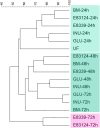Exopolysaccharides From Lactobacillus paracasei Isolated From Kefir as Potential Bioactive Compounds for Microbiota Modulation
- PMID: 33178165
- PMCID: PMC7596202
- DOI: 10.3389/fmicb.2020.583254
Exopolysaccharides From Lactobacillus paracasei Isolated From Kefir as Potential Bioactive Compounds for Microbiota Modulation
Abstract
Microbiota coexists in true symbiosis with the host playing pivotal roles as a key element for well-being and health. Exopolysaccharides from lactic acid bacteria are an alternative as novel potential prebiotics that increase microbiota diversity. Considering this, the aim of the present work was to evaluate the capacity of the EPS produced by two L. paracasei strains isolated from kefir grains, to be metabolized in vitro by fecal microbiota producing short chain fatty acids. For this purpose, fecal samples from healthy children were inoculated in a basal medium with EPS and incubated in anaerobiosis at 37°C for 24, 48, and 72 h. DGGE profiles and the production of SCFA after fermentation were analyzed. Additionally, three selected samples were sequenced by mass sequencing analysis using Ion Torrent PGM. EPS produced by L. paracasei CIDCA 8339 (EPS8339) and CIDCA 83124 (EPS83124) are metabolized by fecal microbiota producing a significant increase in SCFA. EPS8339 fermentation led to an increment of propionate and butyrate, while fermentation of EPS83124 increased butyrate levels. Both EPS led to a profile of SCFA different from the ones obtained with inulin or glucose fermentation. DGGE profiles of 72 h fermentation demonstrated that both EPS showed a different band profile when compared to the controls; EPS profiles grouped in a cluster that have only 65% similarity with glucose or inulin profiles. Mass sequencing analysis demonstrated that the fermentation of EPS8339 leads to an increase in the proportion of the genera Victivallis, Acidaminococcus and Comamonas and a significant drop in the proportion of enterobacteria. In the same direction, the fermentation of EPS83124 also resulted in a marked reduction of Enterobacteriaceae with a significant increase in the genus Comamonas. It was observed that the changes in fecal microbiota and SCFA profile exerted by both polymers are different probably due to differences in their structural characteristics. It can be concluded that EPS synthesized by both L. paracasei strains, could be potentially used as bioactive compound that modify the microbiota increasing the production of propionic and butyric acid, two metabolites highly associated with beneficial effects both at the gastrointestinal and extra-intestinal level.
Keywords: exopolysaccharide; lactic acid bacteria; microbiota; prebiotics; probiotics; short chain fatty acids.
Copyright © 2020 Bengoa, Dardis, Gagliarini, Garrote and Abraham.
Figures




Similar articles
-
Exopolysaccharide-producing Lacticaseibacillus paracasei strains isolated from kefir as starter for functional dairy products.Front Microbiol. 2023 Feb 24;14:1110177. doi: 10.3389/fmicb.2023.1110177. eCollection 2023. Front Microbiol. 2023. PMID: 36910219 Free PMC article.
-
Exopolysaccharides produced by Bifidobacterium longum IPLA E44 and Bifidobacterium animalis subsp. lactis IPLA R1 modify the composition and metabolic activity of human faecal microbiota in pH-controlled batch cultures.Int J Food Microbiol. 2009 Nov 15;135(3):260-7. doi: 10.1016/j.ijfoodmicro.2009.08.017. Epub 2009 Aug 19. Int J Food Microbiol. 2009. PMID: 19735956
-
Effect of a novel animal milk oligosaccharide biosimilar on the gut microbial communities and metabolites of in vitro incubations using feline and canine fecal inocula.J Anim Sci. 2020 Sep 1;98(9):skaa273. doi: 10.1093/jas/skaa273. J Anim Sci. 2020. PMID: 32845316 Free PMC article.
-
A review on traditional Turkish fermented non-alcoholic beverages: microbiota, fermentation process and quality characteristics.Int J Food Microbiol. 2013 Oct 1;167(1):44-56. doi: 10.1016/j.ijfoodmicro.2013.06.016. Epub 2013 Jun 20. Int J Food Microbiol. 2013. PMID: 23859403 Review.
-
Exopolysaccharides Produced by Lactic Acid Bacteria and Bifidobacteria as Fermentable Substrates by the Intestinal Microbiota.Crit Rev Food Sci Nutr. 2016 Jul 3;56(9):1440-53. doi: 10.1080/10408398.2013.770728. Crit Rev Food Sci Nutr. 2016. PMID: 25675369 Review.
Cited by
-
Biological Activity of Lactic Acid Bacteria Exopolysaccharides and Their Applications in the Food and Pharmaceutical Industries.Foods. 2024 May 23;13(11):1621. doi: 10.3390/foods13111621. Foods. 2024. PMID: 38890849 Free PMC article. Review.
-
Characterization and Immunological Activity of Exopolysaccharide from Lacticaseibacillus paracasei GL1 Isolated from Tibetan Kefir Grains.Foods. 2022 Oct 23;11(21):3330. doi: 10.3390/foods11213330. Foods. 2022. PMID: 36359942 Free PMC article.
-
Health-Promoting Properties of Lacticaseibacillus paracasei: A Focus on Kefir Isolates and Exopolysaccharide-Producing Strains.Foods. 2021 Sep 22;10(10):2239. doi: 10.3390/foods10102239. Foods. 2021. PMID: 34681288 Free PMC article. Review.
-
Unravelling the Gastroprotective Potential of Kefir: Exploring Antioxidant Effects in Preventing Gastric Ulcers.Cells. 2023 Dec 8;12(24):2799. doi: 10.3390/cells12242799. Cells. 2023. PMID: 38132119 Free PMC article.
-
Optimization and semi-continuous fermentation of gluco-oligosaccharide production with Weissella cibaria YRK005.Food Sci Biotechnol. 2024 Sep 9;34(4):991-1000. doi: 10.1007/s10068-024-01703-z. eCollection 2025 Mar. Food Sci Biotechnol. 2024. PMID: 39974872
References
-
- Alagón Fernández del Campo P., De Orta Pando A., Straface J. I., López Vega J. R., Toledo Plata D., Niezen Lugo S. F., et al. (2019). The use of probiotic therapy to modulate the gut microbiota and dendritic cell responses in inflammatory bowel diseases. Med. Sci. 7 1–17. 10.3390/medsci7020033 - DOI - PMC - PubMed
-
- Balzaretti S., Taverniti V., Guglielmetti S., Fiore W., Minuzzo M., Ngo H. N., et al. (2017). A novel rhamnose-rich hetero-exopolysaccharide isolated from Lactobacillus paracasei DG activates THP-1 human monocytic cells. Appl. Environ. Microbiol. 83 e2702–e2716. 10.1128/aem.02702-16 - DOI - PMC - PubMed
-
- Bengoa A. A., Iraporda C., Acurcio L. B., de Cicco Sandes S. H., Costa K., Moreira Guimarães G., et al. (2019a). Physicochemical, immunomodulatory and safety aspects of milks fermented with Lactobacillus paracasei isolated from kefir. Food Res. Int. 123 48–55. 10.1016/j.foodres.2019.04.041 - DOI - PubMed
LinkOut - more resources
Full Text Sources

